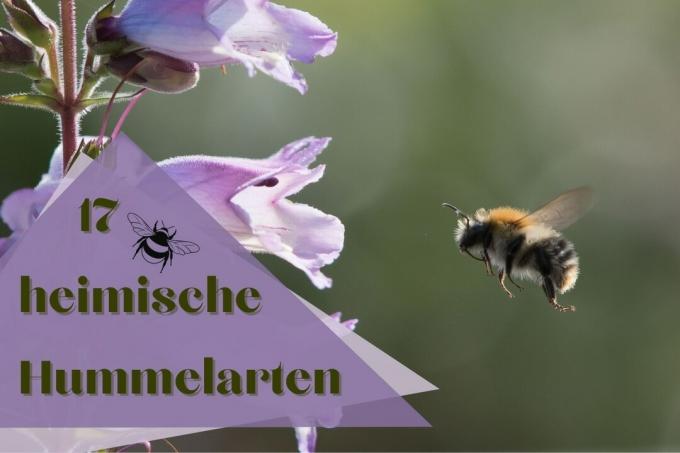
table of contents
- Types from A - E
- Types of F - G
- Types of H - R
- Types from S - Z
- frequently asked Questions
The thick, cozy bumblebees are easy to watch. The large insects belong to the wild bee family and also form states with several hundred animals. We introduce you to the 17 most common native bumblebee species.
In a nutshell
- belong to the wild bees
- form states with several hundred animals
- nest mostly underground, e.g. B. in abandoned mouse nests
- 36 native bumblebee species, many of them threatened with extinction
- only young queens overwinter
Types from A - E
Bumblebee (Bombus pascuorum)
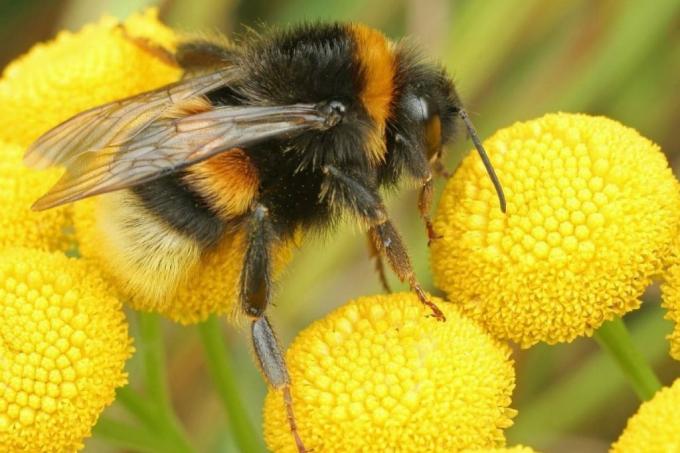
- Body length: 15-18 millimeters (queen), 9-15 millimeters (worker), 12-14 millimeters (drone)
- Colon size: up to 150 specimens
- Color: gray to black, sometimes reddish brown rear part, yellowish to reddish brown trunk
- Nest: under moss cushions and herbaceous layers, in tree hollows, in buildings, in bumblebee boxes
- Frequency: often
Tip: The field bumblebee is considered to be one of the most peaceful bumblebees, and it is very easy to settle in bumblebee boxes.
Tree bumblebee (Bombus hypnorum)
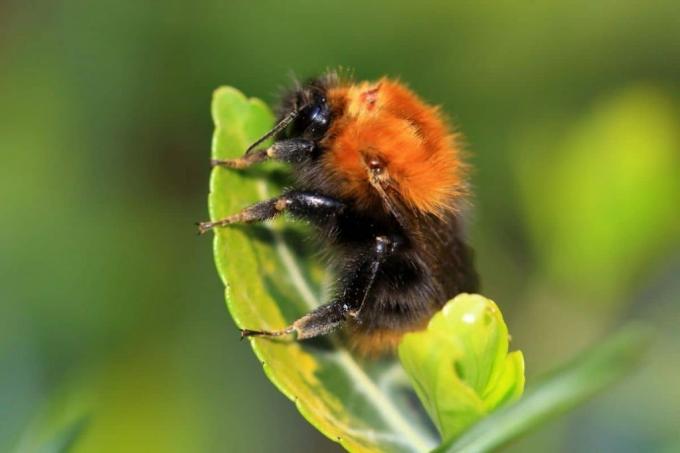
- Body length: 17-20 millimeters (queen), 8-18 millimeters (worker), 14-16 millimeters (drones)
- Colon size: up to 400 specimens
- Color: brown trunk, black belly, brown-white rear part
- Nest: in bird nests or nesting holes, in wall and rock crevices as well as in buildings (attics, stables, barns)
- Frequency: often
Note: The tree bumblebee also often nests in suspended bumblebee boxes. However, this species defends its territory more carefully, which is why it should not come too close to a nest.
Deichbumel (Bombus distinguendus)

- Body length: 19-22 millimeters (queen), 11-18 millimeters (worker), 14-16 millimeters (drones)
- Colon size: up to 120 animals
- Color: golden to brownish-yellow hairs, darkly ringed, yellowish band near the head
- Nest mostly underground (often mouse nests etc.), sometimes also above ground (e. B. in tufts of grass or bird nests)
- Frequency: endangered in Germany
Thistle bumblebee (Bombus soroeensis)

- Body length: 15-17 millimeters (queen), 10-14 millimeters (worker), 12-14 millimeters (drones)
- Colon size: up to 150 animals
- Color: similar to the more common stone bumblebee, but also completely black specimens
- Nest: often underground in mole passages and cuckoo nests
- Frequency: moderately frequent, but the population is declining
Note: This native species of bumblebee is also known as the bluebell bumblebee.
Dark bumblebee (Bombus terrestris)

- Body length: 20-23 millimeters (queen), 11-17 millimeters (worker), 14-16 millimeters (drones)
- Colon size: up to 600 animals
- Coloring: two dark yellow, narrow cross bars near the head
- Nest: mostly underground, up to 150 centimeters deep in mole passages, mouse nests and cavities, sometimes in gaps in walls or under floorboards, in bumblebee boxes
- Abundance: one of the largest and most common species of bumblebee
Types of F - G
European bumblebee (Bombus ruderatus)
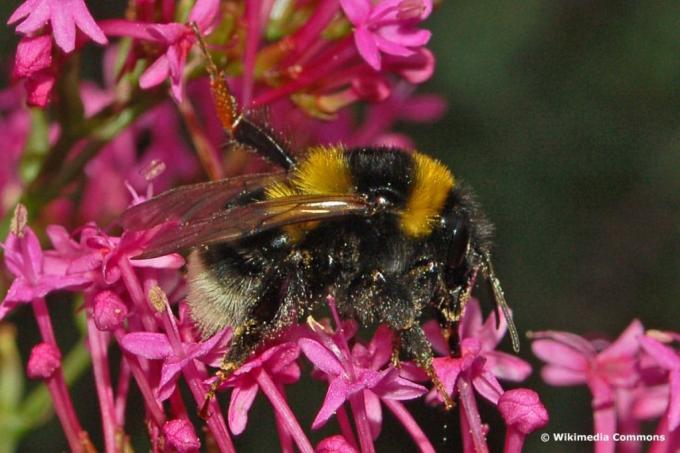
- Body length: 21-24 millimeters (queen), 11-18 millimeters (worker), 15-17 millimeters (drones)
- Colon size: up to 100 animals
- Color: broad, brownish-yellow transverse band near the head, two further transverse bands in the rear area, the rear part with white fur
- Nest: mostly underground, often in mouse nests
- Frequency: rare
Garden bumblebee (Bombus hortorum)
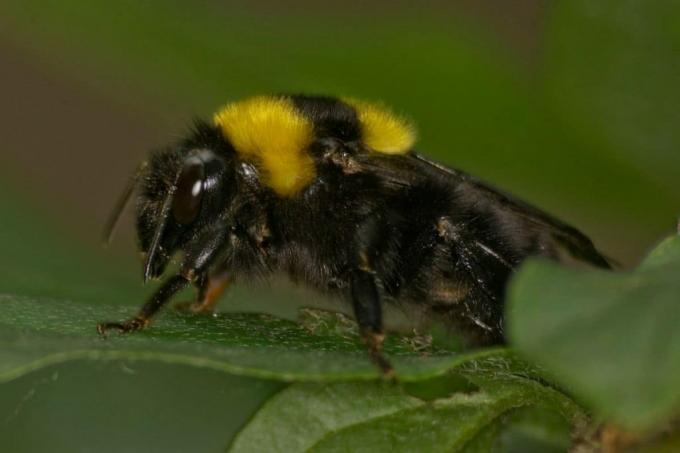
- Body length: 17-22 millimeters (queen), 11-16 millimeters (worker), 13-15 (drones)
- Colon size: up to 120 animals
- Color: brownish to golden yellow cross band near the head, narrow yellow band at the end of the thorax, white rear part
- Nest: underground in mouse nests or above ground in bird nests and cavities, e.g. B. of buildings, bumblebee boxes
- Frequency: relatively common
Note: The garden bumblebee is easily confused by laypeople with the very similar dark bumblebee. However, it has a longer head and a yellow double band in the middle of the body.
Grass bumblebee (Bombus ruderarius)
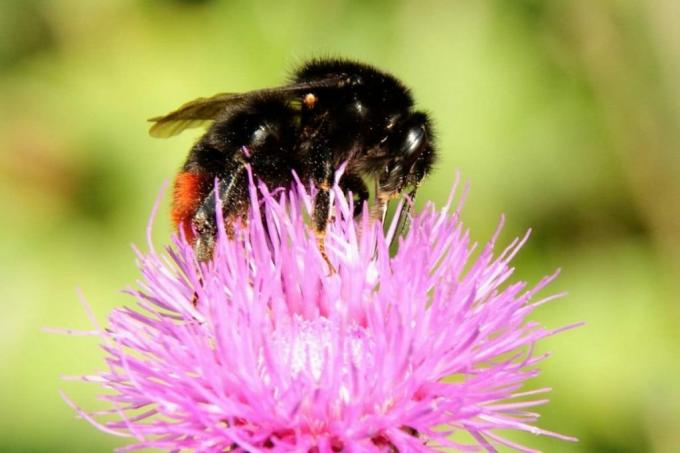
- Body length: 16-18 millimeters (queen), 9-16 millimeters (worker), 12-14 millimeters (drones)
- Colon size: up to 100 animals
- Color: predominantly black, reddish-yellow rump
- Nest: build nests under tufts of grass and moss, in depressions in the ground
- Frequency: endangered in Germany
Note: Like so many native bumblebee species, the grass bumblebee has become rare due to intensive agriculture and the destruction of their habitats.
Off-white bumblebee (Bombus mucidus)
- Body length: 18-20 millimeters (queen), 12-16 millimeters (worker), 13-14 millimeters (drones)
- Colon size: up to 80 animals
- Color: predominantly gray-white with black transverse bands and with a black head
- Habitat: only in the Alps
- Nest: underground, v. a. in mouse nests
- Frequency: regionally limited, quite frequent
Great bumblebee (Bombus magnus)

- Body length: 19-22 millimeters (queen), 11-17 millimeters (worker), 14 to 16 millimeters (drones)
- Colon size: up to 300 animals
- Color: black basic color, two broad, golden-yellow cross bars, gray-white abdomen
- Nest: underground, mostly in mouse nests
- Frequency: endangered
Note: The large earth bumblebee is easy to confuse with the light and dark earth bumblebee. You can differentiate between the types by the thoracic bandage: In the case of the Great Bumblebee, this is approx. two millimeters over the base of the wing.
Types of H - R
Bright earth bumblebee (Bombus lucorum)

- Body length: 18-21 millimeters (queen), 9-16 millimeters (worker), 14-16 millimeters (drones)
- Colon size: up to 400 animals
- Coloring: two approx. two millimeters narrow, light yellow thoracic crossbands, gray-white rear part
- Nest: refers to abandoned, underground mouse nests
- Frequency: regionally quite frequent
Bumblebee (Bombus sichelii)
- Body length: 17-20 millimeters (queen), 13-16 millimeters (worker), 13-15 millimeters (drones)
- Colon size: up to 150 animals
- Color: black with three gray-yellow cross bars
- Habitat: in Germany only in the Bavarian Alps
- Nest: underground in abandoned mouse nests
- Frequency: endangered
Fruit bumblebee (Bombus pomorum)
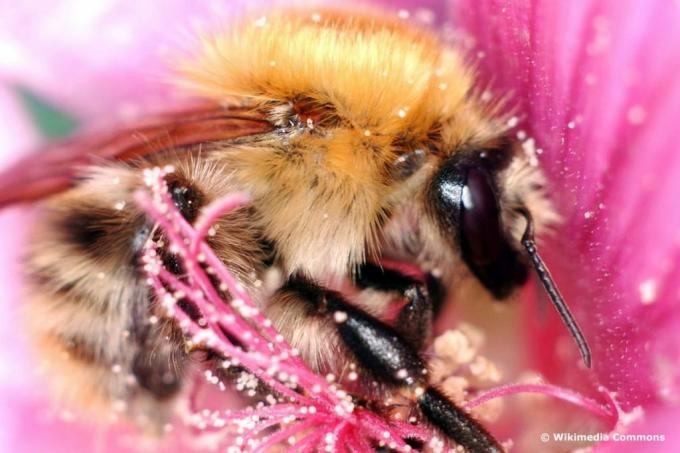
- Body length: 18-20 millimeters (queen), 12-14 millimeters (worker), 15-17 millimeters (drones)
- Colon size: up to 50 animals
- Color: black basic color with gray-white cross band near the head and reddish-yellow abdomen
- Nest: builds nests underground
- Frequency: endangered in Germany
Types from S - Z
Sand bumblebee (Bombus veteranus)
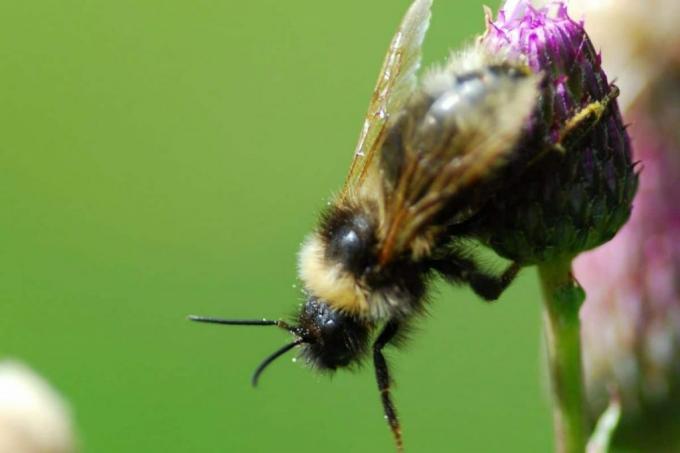
- Body length: 16-19 millimeters (queen), 10-16 millimeters (worker), 12-15 millimeters (drones)
- Colon size: up to 130 animals
- Color: white-gray to dark-gray basic color with white horizontal stripes on the abdomen
- Nest: above ground under tufts of grass and moss cushions, sometimes also in mouse nests
- Frequency: endangered
Note: The sand bumblebee is native to all of Germany, but is mainly found on the north German coast.
Stone bumblebee (Bombus lapidarius)
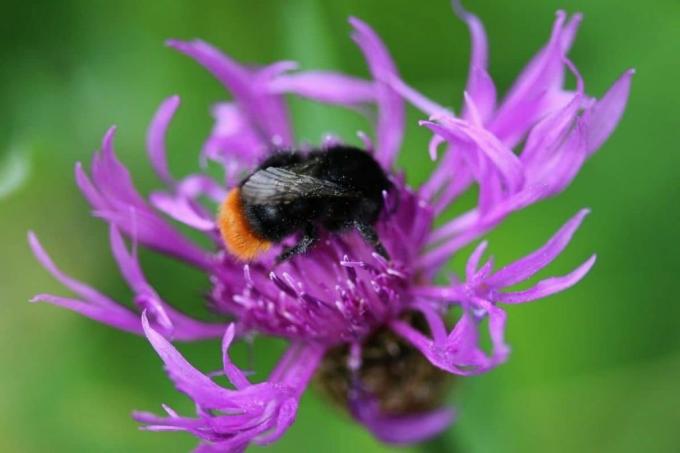
- Body length: 20-22 millimeters (queen), 12-16 millimeters (worker), 14-16 millimeters (drones)
- Colon size: up to 300 animals
- Color: black with red abdomen end
- Nest: often above ground, e.g. B. in walls, cairns, rock gaps, bird and Bumblebee boxes, sometimes underground in mouse nests
Note: The stone bumblebee has a preference for different species of clover, especially horn clover (Lotus corniculatus) and white clover (Trifolium repens).
Wood bumblebee (Bombus sylvarum)
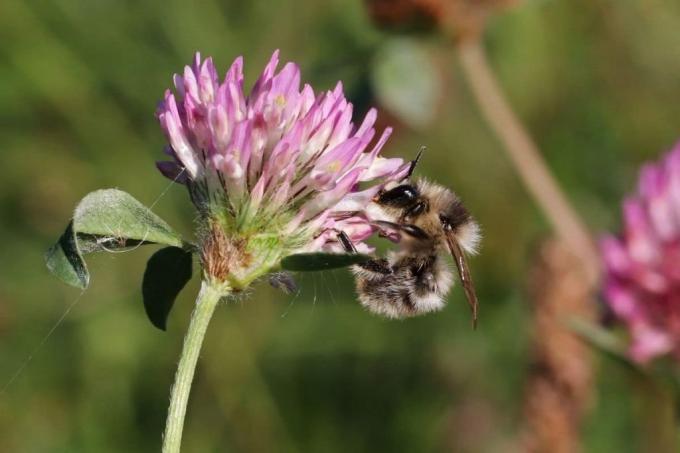
- Body length: 16-18 millimeters (queen), 10-15 millimeters (worker), 12-14 millimeters (drones)
- Colon size: up to 150 animals
- Color: two brownish-yellow transverse bars, light-colored underside of the thorax, abdomen with orange pelts
- Nest: mostly above ground, e.g. B. in squirrel cob or under tufts of grass, sometimes underground
- Frequency: regionally quite frequent, but stocks are declining
Note: Contrary to its name, the wood bumblebee is not found in forests, but, like other native bumblebee species, prefers the edges of forests, orchards, parks and gardens.
Meadow bumblebee (Bombus pratorum)
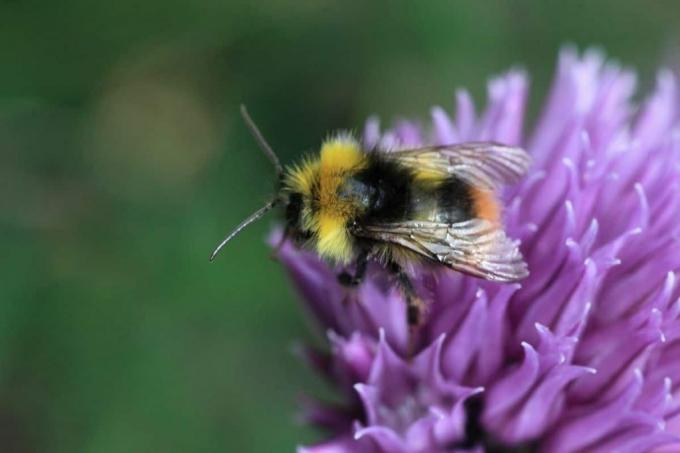
- Body length: 15-17 millimeters (queen), 9-14 millimeters (worker), 11-13 millimeters (drones)
- Colon size: up to 120 animals
- Color: black basic color, yellow cross band on the thorax, reddish orange abdomen
- Nest: mostly above ground, e.g. B. in squirrel cobbles and bird nests, in nesting boxes, under hedges and bushes
- Frequency: quite common
Note: The little meadow bumblebee is the first bumblebee to wake up from its hibernation in spring and found its bumblebee state. For this, the young queens go into hibernation as early as August.
frequently asked Questions
There are around 250 different species of bumblebee around the world, most of which are at home in the cool and temperate climates of the northern hemisphere. There are 36 known native bumblebee species in Germany, but many of them are threatened with extinction or are already extinct.
Cuckoo bumblebees, also known as parasitic bumblebees, do not form a state of their own, which is why there are no workers in these species. Instead, the queen lays her eggs in the nests of other bumblebee species, eating their eggs as well. There are six species of cuckoo bumblebee in Germany.
In contrast to honey bees, where the whole state hibernates, the bumblebee state dies in autumn including the old queen. Only the young queens overwinter who are looking for winter quarters in late summer. Often they bury themselves in molehills or compost heaps.



